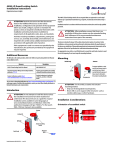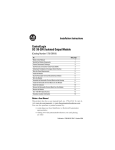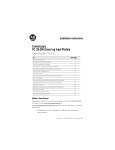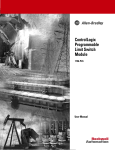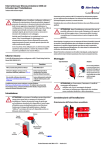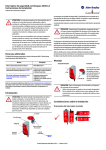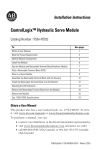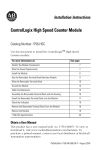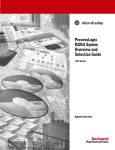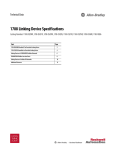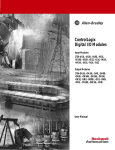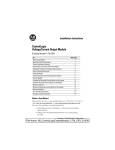Download 1756-OW16I ControlLogix AC (10
Transcript
Installation Instructions
ControlLogix™
AC (10-265V) DC (5-150V) Isolated
Contact Module
Catalog Number 1756-OW16I
To:
See page:
Obtain a User Manual
1
Identify the Module Components
6
Note the Power Requirements
6
Install the Module
7
Key the Module and Removable Terminal Block/Interface Module
8
Wire the Module
10
Assemble the Removable Terminal Block and the Housing
11
Install the Removable Terminal Block onto the Module
11
Check the Indicators
12
Remove the Removable Terminal Block from the Module
13
Remove the Module
13
See Specifications
14
Obtain a User Manual
This product also has a user manual (pub. no. 1756-UM058). To view
it, visit www.ab.com/manuals or www.theautomationbookstore.com.
To purchase a manual, you can:
· contact your distributor or Rockwell Automation representative
· visit www.theautomationbookstore.com and place an order
· call 800.963.9548 (USA/Canada) or 001.320.725.1574 (outside
USA/Canada)
Publication 1756-IN011B-EN-P - February 2003
2 ControlLogix™ AC (10-265V) DC (5-150V) Isolated Contact Module
Important User Information
Because of the variety of uses for the products described in this publication, those
responsible for the application and use of these products must satisfy themselves that all
necessary steps have been taken to assure that each application and use meets all
performance and safety requirements, including any applicable laws, regulations, codes and
standards. In no event will Rockwell Automation be responsible or liable for indirect or
consequential damage resulting from the use or application of these products.
Any illustrations, charts, sample programs, and layout examples shown in this publication
are intended solely for purposes of example. Since there are many variables and
requirements associated with any particular installation, Rockwell Automation does not
assume responsibility or liability (to include intellectual property liability) for actual use
based upon the examples shown in this publication.
Allen-Bradley publication SGI-1.1, Safety Guidelines for the Application, Installation and
Maintenance of Solid-State Control (available from your local Rockwell Automation office),
describes some important differences between solid-state equipment and electromechanical
devices that should be taken into consideration when applying products such as those
described in this publication.
Reproduction of the contents of this copyrighted publication, in whole or part, without
written permission of Rockwell Automation, is prohibited.
Throughout this publication, notes may be used to make you aware of safety considerations.
The following annotations and their accompanying statements help you to identify a
potential hazard, avoid a potential hazard, and recognize the consequences of a potential
hazard:
WARNING
!
Identifies information about practices or circumstances that can cause an
explosion in a hazardous environment, which may lead to personal injury or
death, property damage, or economic loss.
ATTENTION
!
IMPORTANT
Identifies information about practices or circumstances that can lead to
personal injury or death, property damage, or economic loss.
Identifies information that is critical for successful application and
understanding of the product.
ControlLogix is a trademark of Rockwell Automation, Inc.
Publication 1756-IN011B-EN-P - February 2003
ControlLogix™ AC (10-265V) DC (5-150V) Isolated Contact Module 3
Environment and Enclosure
ATTENTION
!
This equipment is intended for use in a Pollution Degree 2 industrial
environment, in overvoltage Category II applications (as defined in
IEC publication 60664-1), at altitudes up to 2000 meters without
derating.
This equipment is considered Group 1, Class A industrial equipment
according to IEC/CISPR Publication 11. Without appropriate
precautions, there may be potential difficulties ensuring
electromagnetic compatibility in other environments due to
conducted as well as radiated disturbance.
This equipment is supplied as "open type" equipment. It must be
mounted within an enclosure that is suitably designed for those
specific environmental conditions that will be present and
appropriately designed to prevent personal injury resulting from
accessibility to live parts. The interior of the enclosure must be
accessible only by the use of a tool. Subsequent sections of this
publication may contain additional information regarding specific
enclosure type ratings that are required to comply with certain
product safety certifications.
See NEMA Standards publication 250 and IEC publication 60529, as
applicable, for explanations of the degrees of protection provided by
different types of enclosure. Also, see the appropriate sections in this
publication, as well as the Allen-Bradley publication 1770-4.1
("Industrial Automation Wiring and Grounding Guidelines"), for
additional installation requirements pertaining to this equipment.
Prevent Electrostatic Discharge
ATTENTION
!
This equipment is sensitive to electrostatic discharge, which can
cause internal damage and affect normal operation. Follow these
guidelines when you handle this equipment:
· Touch a grounded object to discharge potential static.
· Wear an approved grounding wriststrap.
· Do not touch connectors or pins on component boards.
· Do not touch circuit components inside the equipment.
· If available, use a static-safe workstation.
When not in use, store the equipment in appropriate static-safe
packaging.
Publication 1756-IN011B-EN-P - February 2003
4 ControlLogix™ AC (10-265V) DC (5-150V) Isolated Contact Module
Removal and Insertion Under Power
WARNING
!
When you insert or remove the module while backplane
power is on, an electrical arc can occur. This could cause
an explosion in hazardous location installations. Be sure
that power is removed or the area is nonhazardous
before proceeding.
Repeated electrical arcing causes excessive wear to contacts on both
the module and its mating connector. Worn contacts may create
electrical resistance that can affect module operation.
European Zone 2 Use
If you install the module in a European Zone 2 location, consider:
European Zone 2 Certification
This equipment is intended for use in potentially explosive
atmospheres as defined by European Union Directive 94/9/EC.
The LCIE (Laboratoire Central des Industries Electriques) certifies
that this equipment has been found to comply with the Essential
Health and Safety Requirements relating to the design and
construction of Category 3 equipment intended for use in
potentially explosive atmospheres, given in Annex II to this
Directive. The examination and test results are recorded in
confidential report No. 28 682 010.
Compliance with the Essential Health and Safety Requirements has
been assured by compliance with EN 50021 (1999).
Publication 1756-IN011B-EN-P - February 2003
ControlLogix™ AC (10-265V) DC (5-150V) Isolated Contact Module 5
IMPORTANT
When using this product, also consider the following:
· This equipment is not resistant to sunlight or other
sources of UV radiation.
· The secondary of a current transformer shall not be
open-circuited when applied in Class I, Zone 2
environments.
· Equipment of lesser Enclosure Type Rating must be
installed in an enclosure providing at least IP54
protection when applied in Class I, Zone 2
environments.
· This equipment shall be used within its specified
ratings defined by Allen-Bradley.
· Provision shall be made to prevent the rated
voltage from being exceeded by transient
disturbances of more than 40% when applied in
Class I, Zone 2 environments.
Publication 1756-IN011B-EN-P - February 2003
6 ControlLogix™ AC (10-265V) DC (5-150V) Isolated Contact Module
Identify the Module Components
You received the following components with your order:
· 1756-OW16I module
· Removable Terminal Block (RTB) door label
If you did not receive these components, contact your local
distributor Rockwell Automation sales office.
This module mounts in a 1756 chassis and uses a separately-ordered
RTB or a Bulletin 1492 Interface Module (IFM)(1) to connect all
field-side wiring. This module uses one of the following RTBs:
· 1756-TBCH 36 position Cage clamp RTB
· 1756-TBS6H 36 position Spring clamp RTB
Use an extended-depth cover (1756-TBE) for applications with heavy
gauge wiring or requiring additional routing space. When using an
IFM, consult the documentation that came with it to connect wiring.
IMPORTANT
Before you install your module, you should:
· install and ground a 1756 chassis and power supply.
· order and receive an RTB or IFM, and its
components, for your application.
Note the Power Requirements
This module receives power from the 1756 chasis power supply and
requires 2 sources of power from the backplane:
· 150mA at 5.1V dc
· 150mA at 24V dc
Add this current/power value (4.4W) to the requirements of all other
modules in the chassis to prevent overloading the power supply.
Field output supply power should be limited to 10KVA available short
circuit power.
(1)
The Bulletin 1492 IFM may not be used in any application that requires agency certification of the
ControlLogix system. Use of the IFM violates the UL, CSA and FM certifications of this product.
Publication 1756-IN011B-EN-P - February 2003
ControlLogix™ AC (10-265V) DC (5-150V) Isolated Contact Module 7
Install the Module
You can install or remove the module while chassis power is applied.
WARNING
!
When you insert or remove the module while backplane
power is on, an electrical arc can occur. This could cause
an explosion in hazardous location installations. Be sure
that power is removed or the area is nonhazardous
before proceeding.
1. Align the circuit board with the top and bottom chassis guides.
Printed
Circuit
Board
20861–M
2. Slide the module into the chassis until the module locking tabs
click.
Locking tab
20862–M
Publication 1756-IN011B-EN-P - February 2003
8 ControlLogix™ AC (10-265V) DC (5-150V) Isolated Contact Module
Key the Module and Removable Terminal Block/Interface Module
Use the wedge-shaped keying tabs and U-shaped keying bands to
prevent connecting the wrong wires to your module.
Key positions on the module that correspond to unkeyed positions
on the RTB. For example, if you key the first position on the module,
leave the first position on the RTB unkeyed.
1. To key the module, insert the U-shaped band, as shown.
U-shape
d bands
20850–M
2. Push the band until it snaps in place.
3. To key the RTB or IFM, insert the wedge-shaped tab with
rounded edge first, as shown.
Wedge-shaped tab
20851–M
4. Push the tab until it stops.
Reposition the tabs to rekey future module applications.
Publication 1756-IN011B-EN-P - February 2003
ControlLogix™ AC (10-265V) DC (5-150V) Isolated Contact Module 9
Wire the Removable Terminal Block
Wire the RTB with a 1/8 inch (3.2mm) maximum flat-bladed
screwdriver before installing it onto the module.
WARNING
!
When you connect or disconnect the Removable
Terminal Block (RTB) with field side power applied, an
electrical arc can occur. This could cause an explosion in
hazardous location installations. Make sure that power is
removed or the area is nonhazardous before proceeding.
Spring Clamp RTB
Cage Clamp RTB
1. Strip 7/16 inch (11mm) maximum
length of wire.
1. Strip 3/8 inch (9.5mm) maximum
length of wire.
2. Insert the screwdriver into the
inner hole of the RTB.
2. Insert the wire into the open terminal.
3. Turn the screw clockwise to close the
terminal on the wire.
3. Insert the wire into the
open terminal and
remove the screwdriver.
20860-M
20859-M
Publication 1756-IN011B-EN-P - February 2003
10 ControlLogix™ AC (10-265V) DC (5-150V) Isolated Contact Module
Wire the Module
You can only connect wiring to your module through an RTB or IFM.
The example below shows how to wire the module.
1756-OW16I
Isolated wiring
L1-0
L1-0
L1-1
L1-2
L1-2
L1-3
DC-4 (+)
L1-4
L1-5
L1-6
L1-7
Jumper bar
L1-8
(Cut to length)
L1-9
L1-10
L1-11
Non-isolated
L1-12
wiring
L1-13
L1-14
L1-15
L1-15
L1
Not used
2
1
4
3
6
5
8
7
10
9
12 11
14 13
16 15
18 17
20 19
22 21
24 23
26 25
28 27
30 29
32 31
34 33
36 35
L2-0
OUT-0
OUT-1 N.O.
OUT-2 N.O.
OUT-3 N.O.
OUT-4 N.O.
OUT-5 N.O.
OUT-6 N.O.
OUT-7 N.O.
OUT-8 N.O.
OUT-9 N.O.
OUT-10 N.O.
OUT-11 N.O.
OUT-12 N.O.
OUT-13 N.O.
OUT-14 N.O.
OUT-15 N.O
Not used
Not used
L2-2
DC-4 (-)
L2
Daisy chain
to other RTBs
30240-M
NOTES: 1. All terminals with the same name are connected together on the module. For
example, L1 can be connected to either terminal marked L1-15.
2. When daisy chaining the second L1-15 terminal to other RTBs, always connect the
daisy chain to the terminal directly connected to the supply wire, as shown in the
example above. Do not connect more than 2 wires to any single terminal.
3. If separate power sources are used, do not exceed the specified isolation voltage.
After completing field-side wiring, secure the wires in the strain relief
area with a cable-tie.
Publication 1756-IN011B-EN-P - February 2003
ControlLogix™ AC (10-265V) DC (5-150V) Isolated Contact Module 11
Assemble the Removable Terminal Block and the Housing
1. Align the grooves at the bottom of the housing with the side edges of the RTB.
Groove
Side edge of the RTB
Groove
Strain relief area
Side edge of the RTB
2. Slide the RTB into the housing until it snaps into place.
20858–M
Install the Removable Terminal Block onto the Module
WARNING
!
When you connect or disconnect the Removable Terminal Block
(RTB) with field side power applied, an electrical arc can occur.
This could cause an explosion in hazardous location
installations. Be sure that power is removed or the area is
nonhazardous before proceeding.
Before installing the RTB, make certain:
·
·
·
·
field-side wiring of the RTB has been completed.
the RTB housing is snapped in place on the RTB.
the RTB housing is closed.
the locking tab at the top of the module is unlocked.
1. Align the side and top, bottom guides.
2. Press quickly and evenly to seat the RTB
until the latches snap into place.
Locking tab
Module
guide
20853–M
RTB guides
20854–M
3. To lock the RTB on the module,
slide the locking tab down.
Publication 1756-IN011B-EN-P - February 2003
12 ControlLogix™ AC (10-265V) DC (5-150V) Isolated Contact Module
Check the Indicators
The indicators show individual I/O status (yellow) for each point and
a bi-colored LED for module "OK" (red/green).
RELAY OUTPUT
ST 0 1 2 3 4 5 6 7 O
ST 8 9 10 11 12 13 14 15 K
40464
During power up, an indicator test is done and the following occurs:
· "OK" indicator turns red for 1 second and then turns to
flashing green if it has passed the self-test.
· I/O status indicators turn ON for a maximum of 2 seconds and
then turn OFF.
Indicator:
Displaying: Means:
OK
Steady green The outputs are actively being None
light
controlled by a system
processor.
Take this action:
OK
Flashing
green light
The module has passed
internal diagnostics but is not
actively controlled.
OK
Flashing red
light
Previously established
Check controller and chassis
communication has timed out. communication.
OK
Steady red
light
An unrecoverable error has
occurred on the module.
Replace the module.
I/O State
Yellow
The output is active.
None
Configure the module.
This completes installation of the module. Use the following
information to remove the module, if necessary.
Publication 1756-IN011B-EN-P - February 2003
ControlLogix™ AC (10-265V) DC (5-150V) Isolated Contact Module 13
Remove the Removable Terminal Block from the Module
If you need to remove the module, you must remove the RTB first.
WARNING
!
When you insert or remove the module while backplane
power is on, an electrical arc can occur. This could cause
an explosion in hazardous location installations. Be sure
that power is removed or the area is nonhazardous
before proceeding.
Before removing the module, you must remove the RTB.
1. Unlock the locking tab at
the top of the module.
2. Open the RTB door and pull
the RTB off the module.
42517
20855–M
Remove the Module
1. Push in top and bottom locking tabs.
20856–M
2. Pull module out of the chassis.
20857–M
Publication 1756-IN011B-EN-P - February 2003
14 ControlLogix™ AC (10-265V) DC (5-150V) Isolated Contact Module
1756-OW16I Specifications
Number of Outputs
16 N.O. (Contacts individually isolated)
Module Location
1756 ControlLogix Chassis
Backplane Current
150mA @ 5.1V dc & 150mA @ 24V dc
(4.4W Total backplane power)
Maximum Power Dissipation
(Module)
4.5W @ 60oC
Thermal Dissipation
15.35 BTU/hr
Output Voltage Range
10-265V 47-63Hz/5-150V dc
Output Voltage Range
(load dependent)
5-30V dc @ 2.0A resistive
48V dc @ 0.5A resistive
125V dc @ 0.25A resistive
125V ac @ 2.0A resistive
240V ac @ 2.0A resistive
UL Ratings
C300, R150 Pilot Duty
Minimum Load Current
10mA per point
Initial Contact Resistance
30mW
Switching Frequency
1 operation/3s (0.3Hz at rated load) maximum
Bounce Time
1.2ms (mean)
Expected Contact Life
300k cycles resistive/100k cycles inductive
Maximum Off-State Leakage
Current
1.5mA per point
Output Delay Time
OFF to ON
ON to OFF
10ms maximum
10ms maximum
Scheduled Outputs
Synchronization within 16.7 seconds maximum,
reference to the Coordinated System Time
Output Current Rating
(at rated power)
Resistive
2A @ 5-30V dc
0.5A @ 48V dc
0.25A @ 125V dc
2A @ 125V ac
2A @ 240V ac
Publication 1756-IN011B-EN-P - February 2003
Inductive
2.0A steady state @ 5-30V dc
0.5A steady state @ 48V dc
0.25A steady state @ 125V dc
2.0A steady state, 15A make @
125V ac
2.0A steady state, 15A make @
240V ac
ControlLogix™ AC (10-265V) DC (5-150V) Isolated Contact Module 15
Power Rating (steady state)
250W maximum for 125V ac resistive output
480W maximum for 240V ac resistive output
60W maximum for 30V dc resistive output
24W maximum for 48V dc resistive output
31W maximum for 125V dc resistive output
250VA maximum for 125V ac inductive output
480VA maximum for 240V ac inductive output
60VA maximum for 30V dc inductive output
24VA maximum for 48V dc inductive output
31VA maximum for 125V dc inductive output
Configurable Fault States/Point
Hold Last State, ON or OFF (OFF is the default)
Configurable States in Program
Mode per Point
Hold Last State, ON or OFF (OFF is the default)
Fusing
Not protected - Fused IFM can be used to protect
outputs (See publication 1492-2.12). The Bulletin
1492 IFM may not be used in any application that
requires agency certification of the ControlLogix
system. Use of the IFM violates the UL, CSA and FM
certifications of this product.
Isolation Voltage
User to system
250V maximum continuous
100% tested at 2546V dc for 1s
RTB Screw Torque (Cage clamp)
4.4 inch-pounds (0.4Nm) maximum
Module Keying (Backplane)
Software configurable
RTB Keying
User defined mechanical keying
Field Wiring Arm and Housing
36 Position RTB (1756-TBCH or TBS6H)(1)
Environmental Conditions
Operating Temperature
IEC 60068-2-1 (Test Ad, Operating Cold),
IEC 60068-2-2 (Test Bd, Operating Dry Heat),
IEC 60068-2-14 (Test Nb, Operating Thermal Shock):
0 to 60°C (32 to 140°F)
Storage Temperature
IEC 60068-2-1 (Test Ab, Un-packaged Non-operating
Cold),
IEC 60068-2-2 (Test Bb, Un-packaged Non-operating
Dry Heat),
IEC 60068-2-14 (Test Na, Un-packaged Non-operating
Thermal Shock):
–40 to 85°C (–40 to 185°F)
Publication 1756-IN011B-EN-P - February 2003
16 ControlLogix™ AC (10-265V) DC (5-150V) Isolated Contact Module
Relative Humidity
IEC 60068-2-30 (Test Db, Un-packaged Non-operating
Damp Heat):
5 to 95% non-condensing
Vibration
IEC60068-2-6 (Test Fc, Operating):
2g @ 10-500Hz
Shock
IEC60068-2-27 (Test Ea, Unpackaged shock):
Operating 30g
Non-operating 50g
Emissions
CISPR 11:
Group 1, Class A
ESD Immunity
IEC 61000-4-2:
6kV contact discharges
8kV air discharges
Radiated RF Immunity
IEC 61000-4-3:
10V/m with 1kHz sine-wave 80%AM from 30MHz to
1000MHz
10V/m with 200Hz 50% Pulse 100%AM at 900Mhz
EFT/B Immunity
IEC 61000-4-4:
±4kV at 2.5kHz on power ports
±4kV at 2.5kHz on signal ports
Surge Transient
Immunity
IEC 61000-4-5:
±1kV line-line(DM) and ±2kV line-earth(CM) on power
ports
±1kV line-line(DM) and ±2kV line-earth(CM) on signal
ports
Conducted RF Immunity
IEC 61000-4-6:
10Vrms with 1kHz sine-wave 80%AM from 150kHz to
80MHz
Enclosure Type Rating
None (open-style)
Publication 1756-IN011B-EN-P - February 2003
ControlLogix™ AC (10-265V) DC (5-150V) Isolated Contact Module 17
Conductors
Wire Size
#22 to #14 AWG (0.324 to 2.08 sq. mm) stranded(1)
3/64 inch (1.2mm) insulation maximum
Category
1(2), (3)
Screwdriver Blade Width for RTB
1/8 inch (3.2mm) maximum
Certifications
(when product is marked)
UL UL Listed Industrial Control Equipment
CSA CSA Certified Process Control Equipment
CSA CSA Certified Process Control Equipment for
Class I, Division 2 Group A,B,C,D Hazardous
Locations
FM FM Approved Equipment for use in Class I
Division 2 Group A,B,C,D Hazardous Locations
CE(4) European Union 89/336/EEC EMC Directive,
compliant with:
EN 50082-2; Industrial Immunity
EN 61326; Meas./Control/Lab., Industrial
Requirements
EN 61000-6-2; Industrial Immunity
EN 61000-6-4; Industrial Emissions
European Union 73/23/EEC LVD Directive,
compliant with:
EN 61131-2; Programmable Controllers
C-Tick(4) Australian Radiocommunications Act,
compliant with:
AS/NZS 2064; Industrial Emissions
EEx(4)
(1)
(2)
(3)
(4)
European Union 94/9/EEC ATEX Directive,
compliant with:
EN 50021; Potentially Explosive
Atmospheres, Protection “n” when
conformal coated
Maximum wire size requires extended housing - 1756-TBE.
Use this conductor category information for planning conductor routing as described in the system
level installation manual.
Refer to publication 1770-4.1 Industrial Automation Wiring and Grounding Guidelines.
See the Product Certification link at www.ab.com for Declarations of Conformity, Certificates, and
other certification details.
Publication 1756-IN011B-EN-P - February 2003
18 ControlLogix™ AC (10-265V) DC (5-150V) Isolated Contact Module
The following information applies when
operating this equipment in hazardous
locations:
Informations sur l’utilisation de cet équipement
en environnements dangereux :
Products marked “CL I, DIV 2, GP A, B, C, D” are
suitable for use in Class I Division 2 Groups A, B,
C, D, Hazardous Locations and nonhazardous
locations only. Each product is supplied with
markings on the rating nameplate indicating the
hazardous location temperature code. When
combining products within a system, the most
adverse temperature code (lowest “T” number)
may be used to help determine the overall
temperature code of the system. Combinations
of equipment in your system are subject to
investigation by the local Authority Having
Jurisdiction at the time of installation.
Les produits marqués "CL I, DIV 2, GP A, B, C, D" ne
conviennent qu’à une utilisation en environnements de
Classe I Division 2 Groupes A, B, C, D dangereux et
non dangereux. Chaque produit est livré avec des
marquages sur sa plaque d’identification qui indiquent
le code de température pour les environnements
dangereux. Lorsque plusieurs produits sont combinés
dans un système, le code de température le plus
défavorable (code de température le plus faible) peut
être utilisé pour déterminer le code de température
global du système. Les combinaisons d’équipements
dans le système sont sujettes à inspection par les
autorités locales qualifiées au moment de
l’installation.
WARNING
!
EXPLOSION HAZARD
· Do not disconnect
equipment unless power
has been removed or the
area is known to be
nonhazardous.
· Do not disconnect
connections to this
equipment unless power
has been removed or the
area is known to be
nonhazardous. Secure any
external connections that
mate to this equipment by
using screws, sliding
latches, threaded
connectors, or other means
provided with this product.
· Substitution of components
may impair suitability for
Class I, Division 2.
· If this product contains
batteries, they must only be
changed in an area known
to be nonhazardous.
AVERTISSEMENT
Publication 1756-IN011B-EN-P - February 2003
!
RISQUE D’EXPLOSION
· Couper le courant ou s’assurer
que l’environnement est
classé non dangereux avant
de débrancher l'équipement.
· Couper le courant ou s'assurer
que l’environnement est
classé non dangereux avant
de débrancher les
connecteurs. Fixer tous les
connecteurs externes reliés à
cet équipement à l'aide de vis,
loquets coulissants,
connecteurs filetés ou autres
moyens fournis avec ce
produit.
· La substitution de composants
peut rendre cet équipement
inadapté à une utilisation en
environnement de Classe I,
Division 2.
· S’assurer que l’environnement
est classé non dangereux
avant de changer les piles.
ControlLogix™ AC (10-265V) DC (5-150V) Isolated Contact Module 19
Notes:
Publication 1756-IN011B-EN-P - February 2003
Rockwell Automation Support
Rockwell Automation provides technical information on the web to assist you in using
its products. At http://support.rockwellautomation.com, you can find technical
manuals, a knowledge base of FAQs, technical and application notes, sample code and
links to software service packs, and a MySupport feature that you can customize to
make the best use of these tools.
For an additional level of technical phone support for installation, configuration, and
troubleshooting, we offer TechConnect Support programs. For more information,
contact your local distributor or Rockwell Automation representative, or visit
http://support.rockwellautomation.com.
Installation Assistance
If you experience a problem with a hardware module within the first 24 hours of
installation, please review the information that's contained in this manual. You can also
contact a special Customer Support number for initial help in getting your module up
and running.
United States
1.440.646.3223 Monday – Friday, 8am – 5pm EST
Outside United States
Please contact your local Rockwell Automation representative for any
technical support issues.
New Product Satisfaction Return
Rockwell tests all of its products to ensure that they are fully operational when shipped
from the manufacturing facility. However, if your product is not functioning, it may
need to be returned.
United States
Contact your distributor. You must provide a Customer Support case number
(see phone number above to obtain one) to your distributor in order to
complete the return process.
Outside United States
Please contact your local Rockwell Automation representative for return
procedure.
Publication 1756-IN011B-EN-P - February 2003
Supersedes Publication 1756-IN011A-EN-P - October 2000
PN 957726-50
Copyright © 2003 Rockwell Automation, Inc. All rights reserved. Printed in the U.S.A.





















